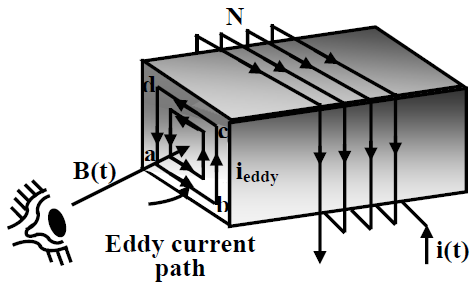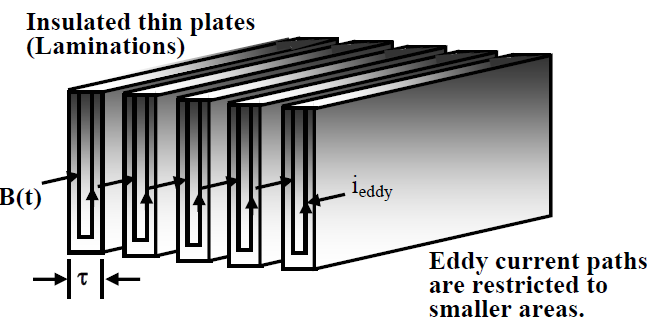Eddy Current
Eddy current: Look at the Figure (A) where a rectangular core of magnetic material is shown along with the exciting coil wrapped around it. Without any loss of generality, one may consider this to be a part of a magnetic circuit. If the coil is excited from a sinusoidal source, exciting current flowing will be sinusoidal too. Now put your attention to any of the cross section of the core and imagine any arbitrary rectangular closed path abcd. An emf will be induced in the path abcd following Faraday’s law. Here of course we don’t require a switch S to close the path because the path is closed by itself by the conducting magnetic material (say iron). Therefore a circulating current ieddy will result. The direction of ieddy is shown at the instant when B(t) is increasing with time. It is important to note here that to calculate induced voltage in the path, the value of flux to be taken is the flux enclosed by the path i.e., φmax=Bmax*area of the loop abcd. The magnitude of the eddy current will be limited by the path resistance, Rpath neglecting reactance effect. Eddy current will therefore cause power loss in Rpath and heating of the core. To calculate the total eddy current loss in the material we have to add all the power losses of different eddy paths covering the whole cross section.
Use of thin plates or laminations for core: We must see that the power loss due to eddy current is minimized so that heating of the core is reduced and efficiency of the machine or the apparatus is increased. It is obvious if the cross sectional area of the eddy path is reduced then eddy voltage induced too will be reduced (Eeddy ∞ area), hence eddy loss will be less. This can be achieved by using several thin electrically insulated plates (called laminations) stacked together to form the core instead a solid block of iron. The idea is depicted in the Figure (B) where the plates have been shown for clarity, rather separated from each other. While assembling the core the laminations are kept closely pact. Conclusion is that solid block of iron should not be used to construct the core when exciting current will be ac. However, if exciting current is dc, the core need not be laminated.
 fig.(A)
fig.(A)
 fig.(B)
fig.(B)